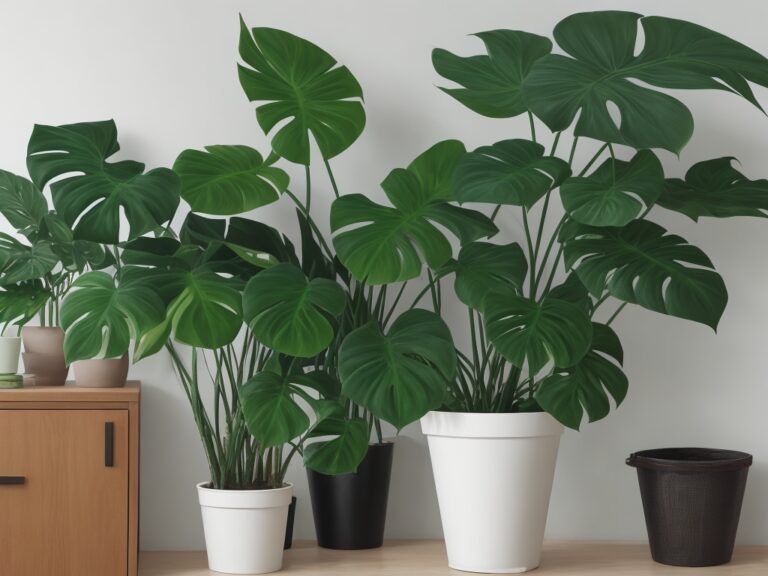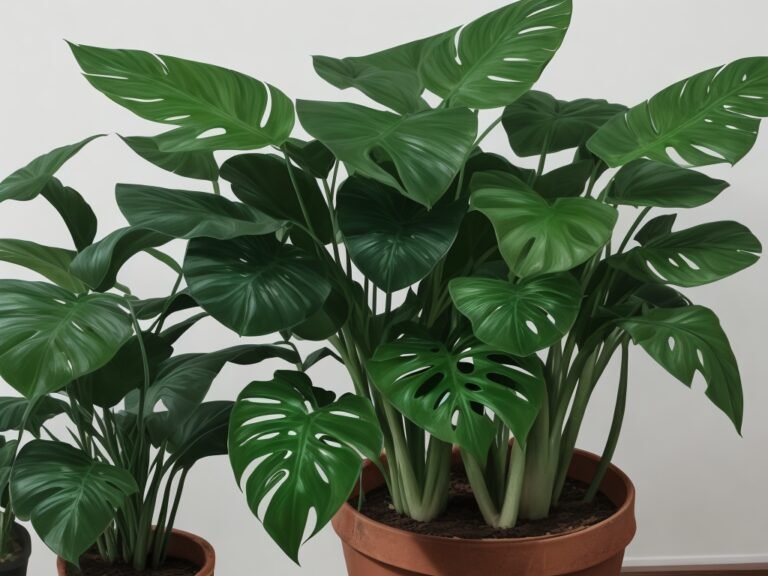Why Did My Monstera Stop Growing New Leaves?
Key Takeaways:
- Inadequate light and temperature can cause your Monstera to stop growing new leaves.
- Overwatering or underwatering your Monstera can also affect its leaf growth.
- Lack of nutrients or improper fertilization can hinder new leaf development in your Monstera.
- Root bound conditions and lack of adequate spacing can also stunt the growth of new leaves in your Monstera.
Have you noticed that your beloved Monstera plant has stopped growing new leaves? It’s disheartening to see your once thriving plant reach a standstill.
But don’t worry, I’ve got you covered! In this article, we’ll dive into the growth cycle of Monstera plants and explore the various factors that can hinder their leaf production.
From inadequate light conditions to pests and diseases, we’ll uncover the common reasons behind the leaf growth slump. But fear not, I’ll also share some practical tips on how to revive and encourage new leaf growth in your Monstera plant.
Let’s get your Monstera back on track to lush greenery!
| Possible Reasons | Solutions |
|---|---|
| The plant is not receiving enough light. | – Move the plant to a brighter location. – Provide additional artificial light if necessary. |
| The plant is not receiving enough water. | – Check the soil moisture and water the plant if it feels dry. – Ensure proper drainage to prevent overwatering. |
| The plant is overwatered. | – Avoid overwatering and allow the soil to dry out slightly between watering. – Ensure proper drainage to prevent waterlogging. |
| The plant is not getting enough nutrients. | – Use a balanced fertilizer to provide necessary nutrients. – Follow a regular fertilization schedule. |
| The plant has outgrown its current pot. | – Repot the Monstera into a larger container to allow room for growth. – Ensure the new pot has proper drainage. |
| The plant is experiencing temperature stress. | – Keep the Monstera in a warm environment with temperatures between 65-85°F (18-29°C). – Avoid exposing the plant to drafty areas. |
| Root rot or pest infestation. | – Inspect the roots for any signs of rot and treat accordingly. – Check for pests such as spider mites or mealybugs and treat with appropriate insecticides. |
Understanding the Growth Cycle of Monstera Plants
Monstera plants have a unique growth cycle that consists of different stages. Understanding this cycle can help you care for your plant better.
The Normal Growth Pattern of Monstera Plants
Monstera plants typically grow new leaves during the spring and summer months. The new leaves start as small, tightly curled buds and gradually unfurl into large, fenestrated leaves.
This growth process can take several weeks or even months.
Occasional growth spurts are normal in Monstera plants, but they may have periods of slower growth or no growth at all during the winter months. It’s important to be patient and provide the necessary care for your Monstera to support its growth.
Factors that Affect Monstera Growth
Several factors can affect the growth of Monstera plants. One crucial aspect is the availability of adequate light.
Monstera plants thrive in bright, indirect sunlight.
Improper watering techniques can also hamper their growth. Overwatering or underwatering can lead to root rot or nutrient deficiencies.
Lack of nutrients can hinder growth as well, so proper fertilization is important.
Additionally, if the Monstera plant becomes pot bound, where its roots outgrow the pot, it may stop growing. Lastly, pests and diseases can harm the plant, so regular monitoring and appropriate treatment are necessary.

Common Reasons Why Monstera Plants Stop Growing New Leaves
A few common reasons why Monstera plants stop growing new leaves include inadequate light conditions, improper watering techniques, lack of nutrients, pot bound roots, and pests or diseases.
Inadequate Light Conditions
Inadequate light conditions can cause your Monstera to stop growing new leaves.
Monstera plants thrive in bright, indirect light.
If they’re not getting enough light, they may slow down leaf production or even stop altogether.
Ensure your plant is placed in a well-lit area, avoiding direct sunlight to prevent leaf burn.
Consider using artificial grow lights if natural light is limited.

Improper Watering Techniques
Improper watering techniques can cause Monstera plants to stop growing new leaves. Overwatering can lead to root rot and oxygen deprivation, while underwatering can cause dehydration and stunted growth.
It’s important to water your Monstera when the top inch of soil is dry, and to ensure proper drainage to prevent waterlogged roots.
Pay attention to the plant’s needs and adjust your watering accordingly. Avoiding extreme fluctuations in moisture levels is key for healthy leaf growth.

Lack of Nutrients
Lack of nutrients can cause your Monstera plant to stop growing new leaves. Without the necessary nutrients like nitrogen, phosphorus, and potassium, the plant’s growth can be stunted.
To address this issue, you can use a balanced fertilizer specifically formulated for houseplants to provide the essential nutrients your Monstera needs.
Pot Bound Monstera Plants
Pot bound Monstera plants occur when the roots outgrow the current pot, limiting growth. Signs include roots emerging from drainage holes, stunted growth, and wilting leaves.
Repot into a larger pot, loosen the root ball gently, and provide proper care to revive growth.
Pests and Diseases
Pests and diseases can hinder the growth of Monstera plants. Some common pests include spider mites, mealybugs, and scale insects.
Diseases like root rot and leaf spot can also affect their health.
Regularly inspect your plants for any signs of pests or diseases and take appropriate measures to eliminate them. Using natural insecticides and practicing good hygiene can help keep your Monstera plants healthy.
How to Revive and Encourage New Leaf Growth in Monstera Plants
To revive and encourage new leaf growth in Monstera plants, try adjusting light conditions, proper watering techniques, fertilizing, repotting, and dealing with pests and diseases.
Adjusting Light Conditions
Adjusting light conditions is crucial for promoting new leaf growth in Monstera plants. Place your Monstera near a bright, indirect light source.
Avoid direct sunlight as it can burn the leaves.
If your plant is not getting enough light, move it closer to a window or provide artificial lighting. Remember to rotate your plant regularly to ensure all sides receive equal light exposure.
Proper Watering Techniques
Proper watering techniques are essential for the healthy growth of Monstera plants. Here are some tips to keep in mind:
- Water thoroughly: When watering, make sure to saturate the entire root ball. This helps prevent water from pooling and ensures that the roots receive adequate moisture.
- Allow for drainage: It’s crucial to use well-draining soil and pots with drainage holes. This allows excess water to escape and prevents waterlogged roots, which can lead to root rot.
- Check the soil moisture: Before watering again, check the moisture level of the soil. Stick your finger about an inch into the soil – if it feels dry, it’s time to water. If it’s still moist, wait a bit longer.
- Avoid overwatering: Overwatering can be just as damaging as underwatering. Make sure not to water too frequently or allow water to accumulate in the saucer beneath the pot.
- Tailor watering to the season: Adjust your watering frequency based on the season. During the warmer months, Monstera plants may need more water, while in the cooler months they require less.
Fertilizing Monstera Plants
To fertilize your Monstera plant, use a balanced, water-soluble fertilizer during the growing season.
Dilute it to half strength and apply every two weeks.
Avoid fertilizing during winter or when the plant is dormant.
Additionally, consider using a fertilizer high in nitrogen to promote leaf growth.
Repotting Pot Bound Monstera Plants
To repot a pot-bound Monstera plant:
- Choose a new pot that is 2-3 inches bigger than the current one.
- Gently remove the plant from the old pot, being careful not to damage the roots.
- Loosen the root ball by gently teasing the roots apart.
- Place fresh, well-draining soil in the new pot.
- Position the plant in the center of the pot and fill in the remaining space with soil.
- Water the plant thoroughly and place it in a well-lit area.
- Avoid overwatering as it can lead to root rot.
- Monitor the plant for signs of new growth and adjust care accordingly.
Dealing with Pests and Diseases
Dealing with pests and diseases in Monstera plants is essential for their overall health and growth. Here are some tips to help you tackle these issues:
- Identify the problem: Look out for signs such as yellowing leaves, spots, or unusual growth. This will help you determine the specific pest or disease affecting your plant.
- Take action promptly: Once you’ve identified the problem, begin treatment immediately. This may involve using organic insecticidal soap or neem oil to combat pests, or applying fungicides for fungal diseases.
- Isolate the affected plant: If you notice pests or diseases in one plant, it’s crucial to separate it from other healthy plants. This prevents the spread of infestation or infection.
- Remove affected leaves or branches: Prune and discard any severely damaged or diseased parts of the plant. This helps prevent the spread of pests and diseases to other areas.
- Maintain good plant hygiene: Regularly clean your Monstera’s leaves with a damp cloth to remove dust and prevent pest infestation. Avoid overwatering, as this can create a favorable environment for diseases to thrive.
- Practice prevention: Ensure your Monstera is placed in a suitable location with adequate light and proper air circulation.
Frequently Asked Questions
How long does it take for Monstera to grow new leaves?
Monstera plants typically take 1-2 months to grow new leaves, but this can vary depending on various factors such as light, water, and nutrients.
Providing optimal conditions and care will help speed up the leaf growth process.
Can underwatering cause Monstera to stop growing new leaves?
Yes, underwatering can cause Monstera plants to stop growing new leaves.
When a Monstera doesn’t receive enough water, it goes into survival mode and conserves energy.
Growth slows down, including the growth of new leaves.
If the plant continues to be underwatered for a prolonged period, it can suffer from dehydration and eventually die.
So, it’s important to water your Monstera properly to promote new leaf growth.
How do I know if my Monstera is pot bound?
To know if your Monstera is pot bound, you can check for the following signs:
- Roots visible on the soil surface or emerging from the drainage holes.
- Sluggish growth or stunted leaves, even with proper care.
- Frequent need for watering or wilting despite sufficient water.
- Pot feels heavy and difficult to lift, indicating crowded roots.
- Plant becoming root-bound, causing roots to circle around the pot.
If you observe any of these signs, it’s likely that your Monstera is pot bound and may benefit from repotting into a larger container.
What are some signs of pests and diseases in Monstera plants?
Some signs of pests and diseases in Monstera plants include yellow or discolored leaves, distorted growth, holes in the leaves, sticky residue on the leaves, wilting or drooping, and the presence of insects like aphids, mealybugs, or spider mites.
Final Verdict
Understanding the growth cycle of Monstera plants is essential for addressing the issue of stunted leaf growth.
Factors such as inadequate light, improper watering techniques, lack of nutrients, pot-bound conditions, and pests or diseases can all contribute to this problem.
However, by adjusting light conditions, practicing proper watering techniques, providing adequate nutrients, repotting when necessary, and addressing pests or diseases, you can revive and encourage new leaf growth in your Monstera plants.
With patience and care, you can enjoy a thriving and lush Monstera plant in your home or garden.






